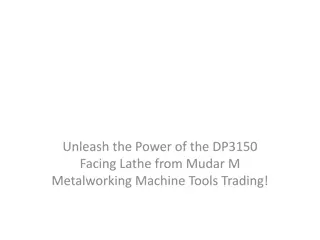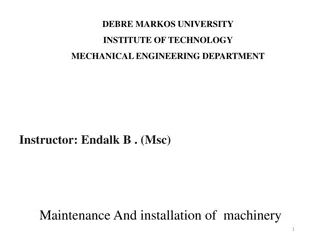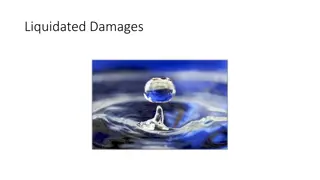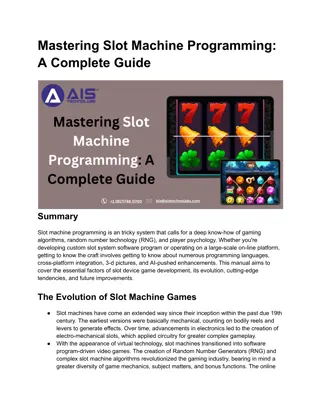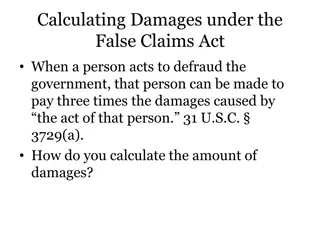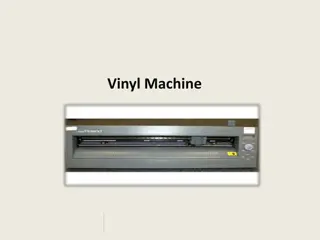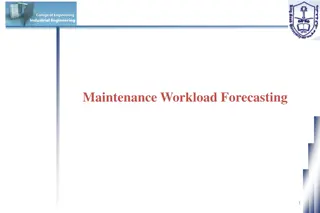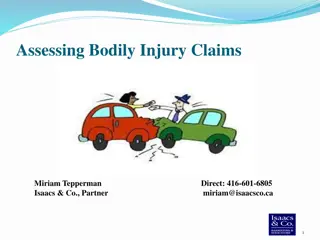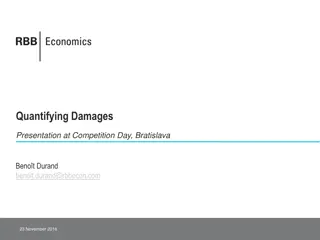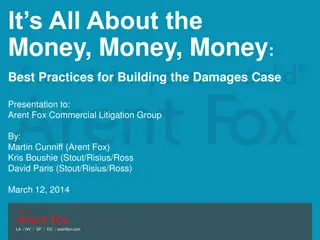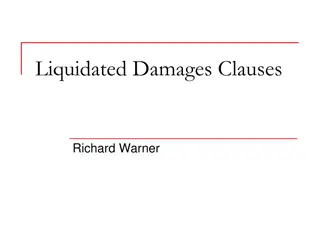Understanding Typical Damages in Machine Parts and Maintenance Techniques
Sliding bearings and anti-friction bearings are prone to damages such as wear, fatigue, and misalignment. Effective maintenance strategies include checking lubrication, shaft deformation, and overall system alignment. Recognition of common defects and implementing preventative measures like knurling and welding can enhance the durability of machinery components.
Download Presentation

Please find below an Image/Link to download the presentation.
The content on the website is provided AS IS for your information and personal use only. It may not be sold, licensed, or shared on other websites without obtaining consent from the author. Download presentation by click this link. If you encounter any issues during the download, it is possible that the publisher has removed the file from their server.
E N D
Presentation Transcript
DEBRE MARKOS UNIVERSITY INSTITUTE OF TECHNOLOGY MECHANICAL ENGINEERING DEPARTMENT Instructor: Endalk B . (Msc) Maintenance And installation of machinery 1
Chapter three Typical Damages of machine parts 3.1. Sliding bearings The damage in sliding bearings is wear and fatigue Static loads cause wear whereas dynamic loads cause wear and fatigue. In cases where lubricant contains corrosion stimulating substances like acids produced by aging lubricant, water leaking in lubricant, etc. , corrosion also becomes an important damage. 2
....contd But when dealing with damages of the system, the whole system has to be considered especially with respect to:- Alignment and shape of bush hole or bore, Lubricating, and Deformation of shaft under applied loads. 3
...contd The process of wear depends on:- wear velocity and operation conditions, particularly, temperature. High temperature and high wear velocity produce overheating which change the properties of the material. Presence of foreign substances in the lab. causes increased wear velocity. 4
Example 5
3.2. Anti - Friction Bearings Roller and ball bearings Ball and roller bearings normally fail by fatigue. In the case of tightening and lubrication problems, wear also can occur . Rarely failure can occur by random damages like overload High contact pressure causes damage of inner and outer races. In case of over load and assembly problems failure takes place in a short time. 7
....contd Wear of bearing elements increases axial and radial play, which can be a cause for vibration leading to increased fatigue. Analysis of damage Due to damages bearings will either get heated up or will run with abnormal noise and/or vibration. 8
Anti - friction bearing defects can be any one or combination of the following:- Bearing inner race loose on shaft, Housing bore loose on shaft, Bearing running dry and Miss-alignment. Avoid it!!! . Using sleeve, . By undergoing knurling, . Welding and . Chromium plating. 9
Examples Caused due to miss alignment Thrust bearing 10
Characteristics of damages in Anti Friction bearings Damage characteristics Reasons for damage 1. Running out of roundness Damage at the rings (pitting, rippling) Contamination roundness Too much bearing clearance 2. Uncommon running noise 2.1. howling, whistling Too small bearing clearance 2.2. Unequal noise: rattling, scrabbling Too big bearing clearance Damage on racing tracks (pitting, toughening, impressions) Contamination Too viscous lubricant 2.3. gradual change of noise Changing of effective bearing clearance (caused by change in temperature Fast fatigue process Fast arising of impressions 3. High temperature 3.1. Overheating Too small bearing clearance Insufficient lubricant Excessive lubricant Lack of lubricant Fast arising of pitting 3.2.Sudden increase in temperature 11
Preventing the damage using lubricant Bearings may be lubricated with grease or with oil depending on working temperature, Speed, load, bearing design and housing design. The general guidelines for use of lubrication in bearings are outlined below:- Grease is used for:- Low temperature up to 1200c Lower speed factors up to 300,000 [?????/???], Low to moderate loads Radial ball and roller bearings, and Relatively simpler housing design. 12
......contd Oils are used For bearing temperature up to 1200C, With higher speed factors up to 500, 000 [?????/???] For all types of bearing designs, and Complex housing design. Generally, the grease should not fill more than three-quarters of the total available free space in the cover. When oils are applied to lubricate bearings, bath or splash system may be used for low speeds; pressure calculating and oil mist systems are used for high speeds. 13
3.3 Gear Damages A gear pair has not failed until it can no longer be run. This condition is reached when any one or both of the following has occurred:- One or more teeth have broken away preventing transmission; Teeth are so badly damaged or worn-out that unacceptable vibration and noise are set up when the gear runs 14
Typical failures of gear Gear failure 1. Surface fatigue (pitting) a. Progressive Pitting Characteristics Causes Remedies Pits continue to form with persistent running Rapid increase may large pieces of teeth breaking away Continuous line of pitting reduces bending resistance in the affected tooth Dedendum covered by a large number of small pits (with mat appearance) formation of a step at the pitch after a continued running Over-stressing of gear Material Remove cause of overload (e.g. correct alignment) b. Deddendum attrition Possibly vibration in the gear unit Use of more viscous lubricant 15
...contd 2. Scuffing a. Light scuffing Tooth surfaces appear dull and slightly rough in comparison with un-affected areas Wear in the direction of sliding at the tip and root of the engaging teeth Tooth surfaces severely roughened as a result of unchecked adhesive wear 3. Abrasive wear a. Foreign matter in oil Disruption of the lubricant film with the gear tooth surfaces temperature reaching critical temperature of lubricating oil Use of low viscous oils Shortage of lubricant Use of high grade oils with higher temperature b. Heavy scuffing Avoid repeated light scuffing Grooves are cut in the tooth flanks in the direction of the sliding Dirt falling in an open gear Inadequate initial gear cleaning Dislodged scale in oil supply pipes Use lubricant Prevent dirt from entering system periodic flushing of gear unit clean 16
Repair of transmission gears 1 Un-uniform tooth wear on one side-Turn over by 1800 - So that the other face would be the working face. 2 Broken teeth -Weld using template 3 Cracked/damaged rim or bore of gear wheel - Replace or weld the rim 18
3.4 Damages of friction surfaces Friction surfaces of clutches and brakes usually fail by wear and/or deformation. Typical clutch typical brake 19
Brake damages Brake metal surface failures, their characteristics and causes Failure Characteristics Causes 1. Heat spotting Heat spotted areas with reddish brown color Distortion causing heavily loaded contact on a small area Uncomfortable mating Overheating Repeated stress cycling from comp. to tension (heating and cooling) Too soft metal for the friction material Abrasive material embedded in the lining material 2. Crazing Randomly oriented cracks on the rubbing surface of mating component Scratches of the rubbing path in the line of movement 3. Scoring 20
....contd Failure 1. Fade Characteristics Material degrades or flows at the friction surface resulting in decreased and loss in performance Causes Over heating caused by excessive braking or brake dragging 2. Metal pickup Metal plucked from the mating member and embedded in the lining Linings contact at ends only Noisy brake Erratic performance Unsuitable combination of materials Incorrect radiating of lining (fault in assembly) 3. Grab 21
Clutch damages Clutch failures, their characteristics and causes 22
3.5. Shaft failures shafts are subjected to various loading condition and experience tension, compression, bending or any combination of these loading conditions These loads can be stationary or may vary with time. The basic causes of shaft failures are wear, fatigue and misalignment. 23
3.5.1 Shaft Failures due to wear Wear is a common cause of shaft failures. The wear process takes place by abrasive wear mechanism which is followed by removal of material from the surface of the shaft. Abrasive wear reduces shaft size and destroys shape of the shaft and causes shaft failure. 24
3.5.2 Fatigue failure One of the more common causes of shaft failure is fatigue. Fatigue failures commonly initiate at stress raisers. The mechanism of fatigue requires the simultaneous presence of three things:- There must be cyclic stresses on the shaft; These stress must be tensile in nature, and There must be plastic strain. 25
....contd The process of fatigue is considered to consist of three stages:- Initial fatigue damage involving plastic strains leading to crack initiation; Crack propagation that continues to grow across the part until the remaining cross section of shaft becomes too weak to carry the imposed loads: and Final and sudden fracture of the remaining cross section, due to overload 26
...contd Some typical shaft features that act as stress raises are Corners, fillets, notches, etc. Key-ways, grooves, splines, etc. Press or shrink fits Welding defects, Metallurgical defects introduced by metal working such as forging, machining, heat treating, etc. Others service-related factors that are important factors in fatigue initiation are damages caused by corrosion and wear 27
3.5.3 Shaft failures due to misalignment Another common cause of shaft failures is misalignment. Misalignment can be introduced due to following problems;- Mismatching of mating parts, Original assembly error of equipment, Any maintenance activity resulting in maintenance induced alignment problems, Deflection or deformation of supporting components, Deflection or deformation of the shaft itself. 28
Remedies of shaft failures Some of the remedies for preventing shaft failures are the following:- by using proper lubrication Misalignment can be eliminated by proper assembly procedures Fatigue can be reduced by proper design of local areas known as stress raisers Avoiding sharp surfaces during machining as much as possible eliminates the formation of stress raisers Use of proper fits and tolerances reduces misalignment, wear and fatigue 29
3.6. Seals Seal - a device or substance that is used to join two things together so as to prevent them from coming apart or to prevent anything from. Basic seal types and their characteristics :- Dynamic seals between surfaces in sliding contact or narrowly separated surfaces. Static seals between surfaces which do not move relative to each other Exclusive seals restrict access of dirt, etc., to a system, often used in conjunction with dynamic seals 30
Rubber seals Symptoms - rubber brittle - possibly cracked - seal leaks Cause Remedy - rubber aging - exposure to the sunlight - overheat due to high fluid temperature or high speed - renew seal - change rubber compound - improve seal environmental or operating conditions - change rubber compound or change fluid - higher or lower speed may avoid problem - Change fluid temperature - change rubber - probably inevitable - effect slowed by softer rubber or more viscous fluid -change rubber compound - rubber softened, possibly swollen seal motion irregular - jerky - vibration - rubber incompatible with sealed fluid -stick-slip phenomena - seal friction very high on starting - static friction (time dependent) - seal permanently deformed - permanent set (characteristic of rubbers) 31
O-rings, rectangular rubber rings, U-rings Symptoms Cause Remedy - Extrusion damage - Reduce back clearance - Check concentricity of parts - Fitting of back-up ring - Use reinforced seal - Use harder rubber - Fine circumferential cut set back slightly from sliding contact zone - Ring completely ejected from its groove - Ring rolling or twisting in groove - Replace O-ring by rectangular section ring or lobed type Ring - Wear (not restricted to sliding contact) - Partial or total fracture 32
Lip seals Cause Symptoms Remedy Rotating lip seal - Excessive leakage - Lip cracked in places - Damaged lip (during assembly) - Remove cause of damage during assembly - Excessive speed - Poor lubrication - Hot environment - Improve lubrication - Reduce environmental temperature - Consider using alternative rubber compound - Replace single seal - Use heavy duty seal - For aqueous fluids leather may be better than rubber Reciprocating lip seal - Excessive wear/high friction - Poor lubrication - Seal overloaded 33


